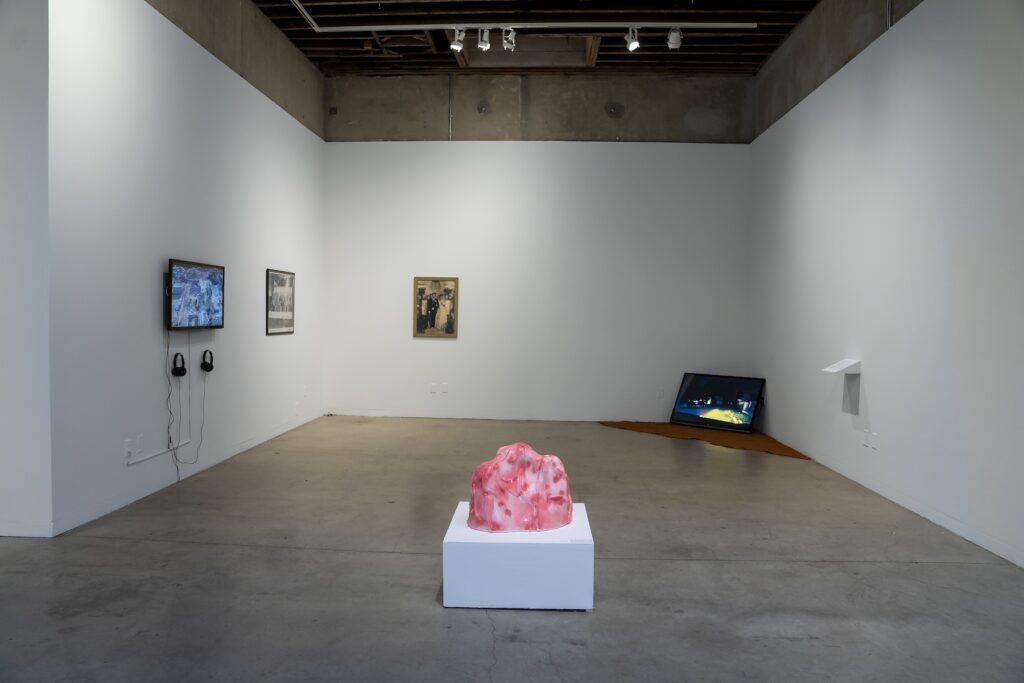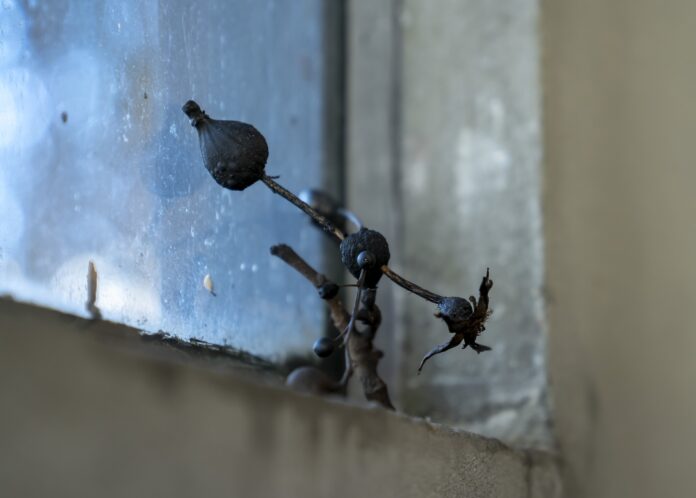The current exhibition at Southern Exposure, Moving Clouds, includes artists like Cliff Hengst , Heesoo Kwon, Saif Azzuz, Melissa Lewis Wong (Deuce Lee) , Umico Niwa , Jes Young, and yétúndé olagbaju. The write up for the show calls them “a gathering of necromancers, ancestor callers, and those unafraid to call upon that which was proclaimed dead and over, but in fact has been fully alive and permeating every aspect of our worlds and beings.”
Ingrid Rojas Contreras’ vivid memoir The Man Who Could Move Clouds inspired curator Cathy Lu to name the show: It recounts Contreras’ experience losing her memory for a time after a head injury and wanting to learn about her family.
“Her grandfather was a curandero, so he was known for his magical abilities, which were passed on to her mother, but it was always something they were taught to be ashamed of because of its relationship to indigenous culture,” Lu said. (Rojas Contreras will read at the gallery on Thu/7.)
“The book was about her coming to terms with family history and the political history of colonialism, so I just thought how powerful it was her being able to channel this history to move herself and her family forward in a way. I thought that was a perfect way to think about the themes in the show about necromancy and challenging those ideas that are bringing up the past and in a way that empowers us instead of holds us back.”

An artist who recently won the prestigious SECA award and has work at the Asian Art Museum’s Into View: New Voices, New Stories, Lu is currently teaching ceramics at Tufts University, along with being artist in residence at Harvard University. In 2021, Lu applied to be on the curatorial council at SoEx to create opportunities for other artists.
“A lot of the artists in the show are ones I was thinking about three years ago [at the start of the process], so it’s interesting, because even within those last few years their careers have developed so much,” Lu said. “It’s special to be able to show this, especially with SoEx being such an important part of our Bay Area arts community.”
The logistics and coordinating were the most challenging part of curating, Lu said. Valerie Imus, the artistic director and co-director of the organization, provided indispensable assistance.
“Val came through with a lot of, ‘OK, but how will that happen?’ I was like, ‘We’ll get soil,’ and she’d say, ‘But from where? And how much do we need?’” Lu said. “I have to give her a lot of kudos for all the work she did in putting the show together.”
Lu says with Moving Clouds is partly about moving through portals.
“I was thinking about this idea of the binaries of life or death, and the idea that it’s separate. I think in a Western tradition, the past is over, the present is now, and the future is later,” Lu said. “That’s kind of the necromancy part, creating channels between all of those different stages.”
For Lu, the best thing about the show is promoting the work of the artists included. Having found herself in a lot of shows of ceramicists or Asian American artists, Lu likes the range of artists and materials, and seeing work like Hengst’s, WOW, which is text based, and a patchwork by Young, All of our flourishing is mutual, in the same show.

Lu also talked about Niwa’s small works, almost hidden throughout the gallery. “The way Umi makes work about transness and queerness and the fragility of existence translates so literally into her work,” Lu said.
In an email, Niwa wrote that she turns organic matter into charcoal, using a Japanese technique called “hana-zumi” which translates to “flower-charcoal.” A friend of hers, who she met at a camp for transgender youth in New Hampshire, took their life recently, Niwa wrote.
“Thinking about cremation, about having a form but the lived essence being long gone,” she wrote. “I guess I’m making less of a statement and more just processing some stuff.”
Lu also talked about Azzuz’s work, which he did with family members Al Sarraj and Lulu Thrower. “I really respect Saif, and I’m happy where his art career has gone. He’s so thoughtful about the way he engages with his community, both socially and politically,” she said. “That’s really inspiring to me. His work was a collaboration with his cousin and wife, which I thought was super-great.”
Azzuz wanted to change his work in the show to respond to what is going on in Gaza, Lu said.
In a phone call, Azzuz said he had planned on making a piece about the carceral way we think about land with some gates. But then he decided he wanted to make something more intimate.
“My cousin Nalan has the video piece he filmed a few years ago. It’s my aunt and my cousin just having this conversation, and it talks about some of the difficulties of living in diaspora and not being able to return, or having to cross in and out of Rafah back into Gaza. It was a more vulnerable way of talking about those things and also of connecting family, which is an important part of my practice,” Azzuz said.
“Lulu’s work was some writing that her aunt had sent to her mom, and some photos of her mom. We had different input about collaborating on this little installation—we wanted you to feel like you were invited to tea, to be a part of this discussion. Such a big part of many communities is having people over and having tea and sweets. There’s a tea pot, and there are some little objects that point to everyone’s different cultural intersections.”
Azzuz says he is grateful to Lu and Southern Exposure for letting him change what he wanted to do for the show about a month before it opened. “I appreciated their flexibility,” he said. “Very few institutions are willing to have the conversation, let alone be flexible about it being last minute.”
MOVING CLOUDS runs through Sat/9 at Southern Exposure, SF. More info here. On Thu/7 at 7pm, Ingrid Rojas Contreras will read from The Man Who Could Move Clouds, followed by a conversation with artists in the exhibition.
.





